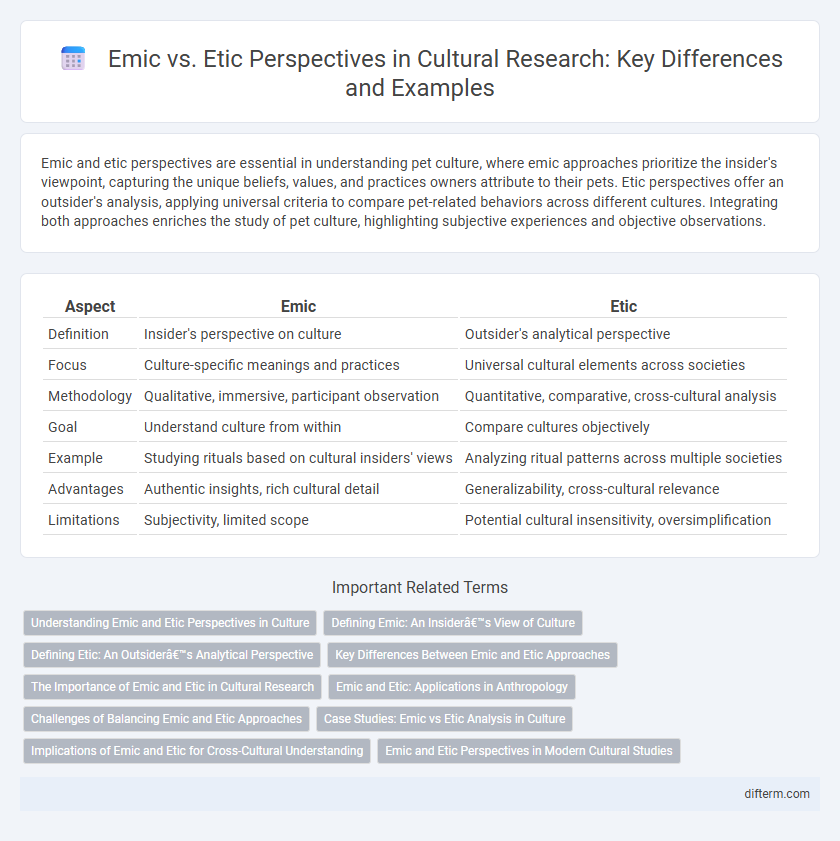Emic and etic perspectives are essential in understanding pet culture, where emic approaches prioritize the insider's viewpoint, capturing the unique beliefs, values, and practices owners attribute to their pets. Etic perspectives offer an outsider's analysis, applying universal criteria to compare pet-related behaviors across different cultures. Integrating both approaches enriches the study of pet culture, highlighting subjective experiences and objective observations.
Table of Comparison
| Aspect | Emic | Etic |
|---|---|---|
| Definition | Insider's perspective on culture | Outsider's analytical perspective |
| Focus | Culture-specific meanings and practices | Universal cultural elements across societies |
| Methodology | Qualitative, immersive, participant observation | Quantitative, comparative, cross-cultural analysis |
| Goal | Understand culture from within | Compare cultures objectively |
| Example | Studying rituals based on cultural insiders' views | Analyzing ritual patterns across multiple societies |
| Advantages | Authentic insights, rich cultural detail | Generalizability, cross-cultural relevance |
| Limitations | Subjectivity, limited scope | Potential cultural insensitivity, oversimplification |
Understanding Emic and Etic Perspectives in Culture
Emic perspectives prioritize insider knowledge, capturing cultural meanings and practices unique to a specific group, while etic perspectives offer an outsider's analytical view, enabling cross-cultural comparisons. Understanding both approaches enriches cultural analysis by balancing subjective experiences with objective frameworks. Integrating emic and etic views facilitates deeper insights into cultural dynamics and human behavior.
Defining Emic: An Insider’s View of Culture
Emic perspective emphasizes understanding culture from within, capturing the beliefs, values, and practices unique to the community studied. This insider's view reveals how members interpret their own behaviors, language, and social norms, providing depth to cultural analysis. Emic approaches contrast with etic methods by prioritizing subjective meaning over external observations.
Defining Etic: An Outsider’s Analytical Perspective
Etic refers to an analytical perspective that examines cultural phenomena from an outsider's viewpoint, focusing on universal categories and frameworks applicable across different societies. This approach prioritizes objective, comparative analysis to identify patterns and structures beyond specific cultural contexts. Ethnographers employing etic methods aim to create generalizable knowledge by interpreting behaviors and beliefs through standardized concepts.
Key Differences Between Emic and Etic Approaches
Emic and etic approaches differ primarily in perspective and methodology within cultural studies. Emic approaches prioritize understanding culture from an insider's viewpoint, emphasizing subjective meanings and native categories. Etic approaches analyze cultures from an outsider's perspective, applying universal concepts and objective criteria to compare and interpret cultural phenomena.
The Importance of Emic and Etic in Cultural Research
Emic perspectives provide insider insights essential for understanding cultural meanings and practices from within a community, enriching qualitative data with nuanced interpretations. Etic approaches offer objective, cross-cultural comparisons through standardized frameworks, enabling researchers to identify universal patterns and contrasts. Combining emic and etic methods enhances the depth and validity of cultural research by integrating subjective experiences with external analysis.
Emic and Etic: Applications in Anthropology
Emic and etic approaches in anthropology provide essential frameworks for understanding cultural phenomena from insider and outsider perspectives, respectively. Emic methods prioritize the subjective meanings and customs within a culture, while etic approaches analyze behaviors using external, comparative categories. These dual perspectives enable anthropologists to comprehensively interpret cultural practices and enhance cross-cultural understanding.
Challenges of Balancing Emic and Etic Approaches
Balancing emic and etic approaches in cultural research involves navigating the challenge of maintaining insider perspectives while ensuring objective analysis. Emic approaches capture deep, culturally specific meanings that can be overlooked by etic methods, which provide comparative frameworks across cultures. Researchers must carefully integrate these perspectives to avoid biases and preserve the authenticity of cultural experiences while achieving cross-cultural validity.
Case Studies: Emic vs Etic Analysis in Culture
Case studies comparing emic and etic analysis in culture reveal distinct insights: emic approaches capture insider perspectives and culturally specific meanings, while etic frameworks provide external, cross-cultural comparisons using universal concepts. For instance, an emic study of ritual practices uncovers nuanced symbolic meanings unique to the culture, whereas an etic analysis assesses these rituals against broader anthropological theories. Balancing emic and etic data enhances comprehensive understanding of cultural phenomena by integrating subjective experiences with objective criteria.
Implications of Emic and Etic for Cross-Cultural Understanding
Emic perspectives prioritize understanding cultural phenomena from within the cultural context, revealing nuanced meanings and insider views crucial for authentic interpretation. Etic approaches apply external frameworks and categories, enabling cross-cultural comparisons and identifying universal patterns across diverse societies. Balancing emic and etic perspectives enhances cross-cultural understanding by combining deep cultural immersion with objective analysis, reducing misinterpretations and fostering more effective intercultural communication.
Emic and Etic Perspectives in Modern Cultural Studies
Emic and etic perspectives are fundamental in modern cultural studies, with the emic approach emphasizing understanding cultures from the insider's viewpoint, capturing native meanings and practices. This perspective prioritizes participants' subjective experiences, enabling researchers to interpret cultural phenomena within their specific social and linguistic contexts. Contrastingly, the etic perspective adopts an outsider's analytical framework to compare cultures objectively, but contemporary scholarship increasingly values the emic approach for its depth in uncovering nuanced cultural insights.
emic vs etic Infographic

 difterm.com
difterm.com